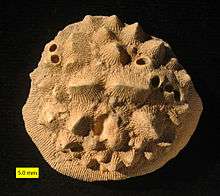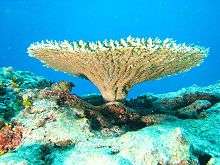Hexacorallia
Hexacorallia is a class of Anthozoa comprising approximately 4,300 species of aquatic organisms formed of polyps, generally with 6-fold symmetry. It includes all of the stony corals, most of which are colonial and reef-forming, as well as all sea anemones, and zoanthids, arranged within five extant orders.[2] The hexacorallia are distinguished from another class of Anthozoa, Octocorallia, in having six or fewer axes of symmetry in their body structure; the tentacles are simple and unbranched and normally number more than eight.[3] These organisms are formed of individual soft polyps which in some species live in colonies and can secrete a calcite skeleton. As with all Cnidarians, these organisms have a complex life cycle including a motile planktonic phase and a later characteristic sessile phase. Hexacorallia also include the significant extinct order of rugose corals.
| Hexacorallia | |
|---|---|
.jpg) | |
| A stony coral, Acropora latistella | |
| Scientific classification | |
| Kingdom: | Animalia |
| Phylum: | Cnidaria |
| Class: | Anthozoa |
| Subclass: | Hexacorallia |
| Orders | |


Phylogeny
Hexacorallia is considered to be monophyletic, that is all contained species are descended from a common ancestor, however it has been suggested that many of the current orders are not. Historically, Antipatharia was considered to be in a separate class called Ceriantipatharia, though more recent genetic studies place it in Hexacorallia.[2]
The subclass includes important coral reef builders such as the stony corals, sea anemones, and zoanthids. The recognized orders are shown below:[4]
- Actiniaria - sea anemones
- Antipatharia - black corals
- Corallimorpharia - corallimorpharians aka "false corals"
- †Rugosa - rugose corals
- Scleractinia - stony corals
- †Tabulata - tabular corals
- Zoantharia - zoanthids
References
- Han, Jian; Kubota, Shin; Uchida, Hiro-omi; Stanley Jr., George D.; Yao, Xiaoyong; Shu, Degan; Li, Yong; Yasui, Kinya (October 13, 2010). "Tiny Sea Anemone from the Lower Cambrian of China". PLOS One. 5 (10): e13276. doi:10.1371/journal.pone.0013276. PMC 2954142. PMID 20967244.
- Daly, M.; Brugler, M.P.; Cartwright, P.; Collins, A.G.; Dawson, M.N.; Fautin, D.G.; France, S.C.; McFadden, C.S.; Opresko, D.M.; Rogriguez, E.; Romano, S.L.; Stake, J.L. (2007-07-21). "The phylum Cnidaria: A review of phylogenetic patterns and diversity 300 years after Linnaeus". Zootaxa. 1668: 1–766. doi:10.11646/zootaxa.1668.1.11. hdl:1808/13641. ISSN 1175-5326.
- Light. Sol Felty (2007). The Light and Smith Manual: Intertidal Invertebrates from Central California to Oregon. University of California Press. p. 177. ISBN 978-0-520-23939-5.
- "WoRMS - World Register of Marine Species - Hexacorallia". marinespecies.org. Retrieved 2018-04-03.
